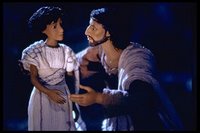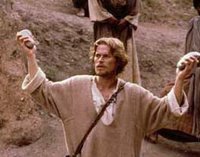 I thought a good way to resurrect this blog would be to revisit some of the film portrayals of the Nativity story in the run up to Christmas. It's a good way to attempt to ensure that the kids don't get so focussed on the fat guy in the red suit that they forget about why we celebrate Christmas in the first place.
I thought a good way to resurrect this blog would be to revisit some of the film portrayals of the Nativity story in the run up to Christmas. It's a good way to attempt to ensure that the kids don't get so focussed on the fat guy in the red suit that they forget about why we celebrate Christmas in the first place. In many ways Il Vangelo Secondo Matteo (The Gospel According to St. Matthew) is not an obvious place to start with a 3 year old and a 5 year old, but the more I thought about it, the more it seemed like an interesting idea. Firstly I occasionally hear some of my friends complain that all their kids ever watch is cartoons. That's always seemed a shame to me, so we've always tried to give them a mix of cartoons/CGI with films with people. The Adventures of Robin Hood (1938) and Singin' in the Rain (1952) have long been favourites and there are plenty of others.
Secondly, I also want to broaden their horizons so they are not just limited to Anglo-American fare. Studio Ghibli is a great place to start, and the more I thought about it the more I could see Pasolini's film as being another easy access point. After all they are already familiar with the Nativity story, and this part of the film has relatively little dialogue. As it happens Nina has all kinds of snippets of language under her belt that are unknown to me: just the other day she was saying hello in Romanian or Albanian (she wasn't quite sure which) that she had picked up from a Romanian/ Albanian friend at school.
There's a third reason as well that Il Vangelo is good place to start. Most images of the nativity picture it rather laviously. Mary wears royal blue and salmon pink robes, the wise men are dressed as kings, even the shepherds are relatively handsome. Pasolini cuts his images from a more basic fabric. His wise men - clearly rich due to their substantial entourages - are ordinary looking. They have time weathered faces and their dress is - compared to their rivals from other films - relatively threadbare. When they bring their gifts they are not conveniently smelted lumps of gold nicely packaged in a decorative case, they are a selection of jugs and goblets held in a blanket (I have Nina to thank for drawing my attention to that).
Whilst there are many anachronisms in Pasolini's images, clothes and backgrounds, his locating of the story primarily in a peasant culture, in a poorer, less luxurious age is quite striking, and a nice antidote to the typical religious Christmas card image.
Aside from the educational advantages that Pasolini's film provides, it's also just a great piece of filmmaking. One of my favourite moments in all cinema is the silent arrival of the magi accompanied by the haunting sounds of Odetta's "Sometimes I Feel Like a Motherless Child". It's remarkably moving and poignant and captures the holiness and spirituality of the moment, whilst simultaneously highlighting the relative loneliness of Jesus' birth and calling compared to most these days.
The other major segment of this part of the film is, of course, the annunciation. This is also simply wonderful. The opening dialogue-free scenes convey far more in their close-ups and images than most films with dialogue. Mary has, presumably, just told Joseph of her pregnancy and is at a loss for any further explanation. Joseph is similarly speechless. When the angel appears in a dream there are no flashing lights, just a girl in a white dress against a toned down background sound. The reconciliation is similarly wordless. In a sense little has changed - neither can find the words to express what is going on. Yet clearly, in another sense everything has changed. Margherita Caruso (Mary) allows the corners of her mouth to flicker the smallest bit at Joseph's return, and then Pasolini makes us wait for what feels like an age before allowing her a proper smile. The delay triggers a far greater emotional response than such a flicker of happiness would normally provide.
Around these two scenes we get Herod and his cronies, again ordinary looking, but with a nicely underplayed hint of the sinister, and the girl angel appearing again to Joseph and the magi to warn them of the impending attack from Herod. The later is again wordless. The angel stands in their path, looks in one direction and then leas them in another.
The gamble worked. The kids enjoyed it, even the three year old Digory managed sat relatively engrossed, and Nina declared at the end "I like watching Italian film". As a lover of Pasolini and Rossellini's neo-realist cinema I can't wait until she can read well enough to be able to introduce her to some more.





































